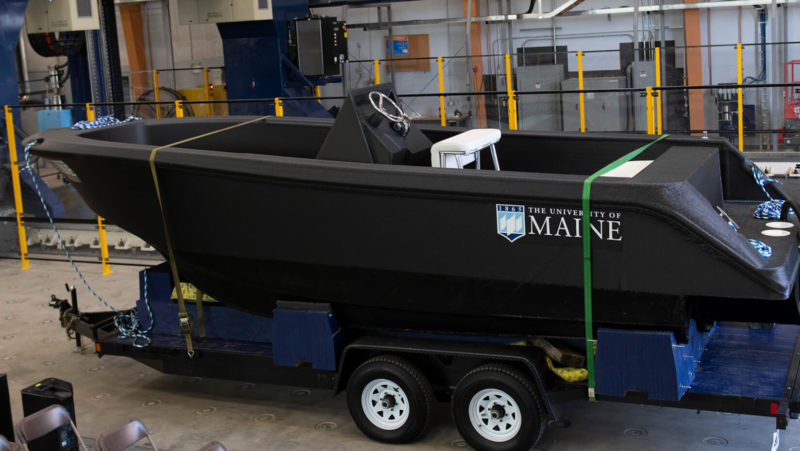More than 250 federal and state officials, business executives, University of Maine System leaders and community members were on hand to witness the UMaine Advanced Structures and Composites Center receive three Guinness World Records on Oct. 10 for the world’s largest prototype polymer 3-D printer, largest solid 3D-printed object, and largest 3-D-printed boat.
The event culminated with the world’s largest 25', 5,000 lb. 3-D-printed boat, named 3Dirigo, being tested in the Alfond W2 Ocean Engineering Laboratory, an offshore model testing facility equipped with a high-performance wind machine over a multidirectional wave basin.
The ceremony was a milestone in UMaine’s leadership in cutting-edge composite material research and development, and commitment to use Maine’s vast natural resources to drive innovation that generates major economic development opportunities in the state and beyond.
The new 3-D printer is designed to print objects as long as 100'x22'x10' and can print at 500 lbs. per hour. The one-of-a-kind printer will support several ambitious initiatives, including development of biobased feedstocks using cellulose derived from wood resources, and rapid prototyping of civilian, defense and infrastructure applications.
To demonstrate the new printer’s capabilities, UMaine 3-D printed a 25' patrol boat with a hull form developed by ship designer Navatek, aa UMaine Composites Center industrial partner. The 5,000-lb. boat was printed in 72 hours — from Sept. 19 to Sept. 22. The massive printer, with both additive and precise subtractive manufacturing capabilities, enables rapid prototyping for both defense and civilian applications.
UMaine also showcased a 3-D-printed, 12' Army communications shelter. The new printer will support programs with the U.S. Army Combat Capabilities Development Command (CCDC) Soldier Center and its mission to develop rapidly deployable shelter systems for soldiers. Other use areas include concealment applications, structural shelters and high-temperature fire retardant materials for vehicle-mounted shelters.
A $20 million research collaboration with Oak Ridge National Laboratory (ORNL), the U.S. Department of Energy’s largest science and energy laboratory, will support fundamental research in key technical areas in large-scale, biobased additive manufacturing. The partnership between UMaine and ORNL will advance efforts to produce new biobased materials conducive to 3-D printing of large, structurally demanding systems. The research will focus on cellulose nanofiber (CNF) production, drying, functionalization and compounding with thermoplastics, building on UMaine’s leadership in CNF technology and extrusion research. By placing CNF from wood into thermoplastics, bioderived recyclable material systems can be developed with properties that may rival traditional materials, possibly even metals.
Biobased feedstocks are recyclable and economical, providing competitive advantages for Maine’s manufacturing industries, including boatbuilding. The UMaine Composites Center received $500,000 from the Maine Technology Institute (MTI) to form a technology cluster to help Maine boatbuilders explore how large-scale 3-D printing using economical, wood-filled plastics can provide the industry with a competitive advantage.
The cluster brings together the expertise of UMaine researchers and marine industry leaders to further develop and commercialize 3-D printing to benefit boatbuilders in the state. By 3-D printing plastics with 50% wood, boat molds and parts can be produced much faster and are more economical than today’s traditional methods.
Working with the U.S. Army Corps of Engineers, the 3-D printer will further advance UMaine’s groundbreaking innovations in rapidly deployable, low-logistics infrastructure systems. That includes a 5,000-lb., 21' 3D-printed mold for a new 76' composites bridge girder. The girder has been licensed to a UMaine spinoff company, Advanced Infrastructure Technology, that is in the process of fabricating girders for a bridge to be constructed in Hampden, Maine in summer 2020. In addition, rapid production of stay-in-place concrete formwork is a potential solution for both infrastructure and coastal resiliency construction applications.
“I was delighted to join UMaine’s celebration unveiling the world’s largest 3-D printer and largest 3-D-printed object,” Sen. Susan Collins, R-Maine, said in a statement announcing the record achievement. “The future of the [UMaine] Composites Center is bright, thanks to the excellent working relationship between UMaine, Oak Ridge National Laboratory and many other federal agencies, which will support next-generation, large-scale additive manufacturing with biobased thermoplastics. As a senior member of the Senate Appropriations Committee, I helped secure $20 million for this exciting collaboration, and an additional $20 million is included in the committee-approved energy funding bill. By working together, UMaine and Oak Ridge will strengthen environmentally responsible advanced manufacturing throughout America, as well as the forest-products industry in Maine.”
“Maine is the most forested state in the nation, and now we have a 3-D printer big enough to make use of this bountiful resource,” said Sen. Angus King, I-Maine. “Today marks the latest innovative investment in Maine’s forest economy, which will serve to increase sustainability, advance the future of biobased manufacturing and diversify our forest products industry. This is a huge opportunity for the state of Maine, and I’m grateful to everyone — especially the University of Maine and the FOR/Maine initiative — for their work to make this day a reality.”





